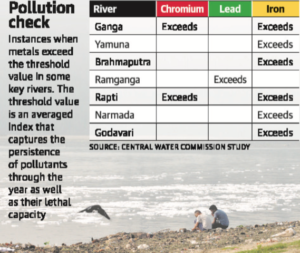UPSC Articles
River Pollution
Part of: GS Prelims and GS Mains III – Environment Conservation
In News
- Samples taken from two-thirds of the water quality stations spanning India’s major rivers showed contamination by one or more heavy metals, exceeding safe limits set by the Bureau of Indian Standards.
- The study spanned 67 rivers in 20 river basins and was conducted by Central Water Commission (CWC) from May 2014 to April 2018.
- Iron emerged as the most common contaminant with 156 of the 442 sampled sites registering levels of the metal above safe limits.
- None of the sites registered arsenic levels above the safe limit.
- The other major contaminants found in the samples were lead, nickel, chromium, cadmium and copper.
- Source of metal pollution: Mining, milling, plating and surface finishing industries that discharge a variety of toxic metals into the environment.
- The presence of metals in drinking water is to some extent unavoidable and certain metals, in trace amounts, required for good health. However, when present above safe limits, they are associated with a range of disorders.
- Health Impact: Long-term exposure to the above-mentioned heavy metals may result in slowly progressing physical, muscular, and neurological degenerative processes that mimic Alzheimer’s disease, Parkinson’s disease, muscular dystrophy and multiple sclerosis.

Daily Current Affairs IAS | UPSC Prelims and Mains Exam – 12th December 2019














